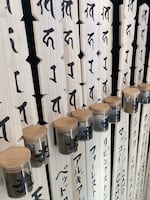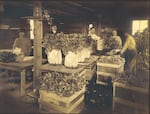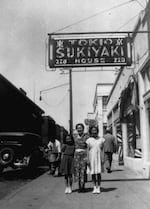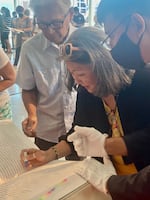This September, soil from 75 former Japanese American incarceration sites — including one in Portland — was collected as part of the Irei: National Monument for the WWII Japanese American Incarceration.
The project aims to memorialize the Japanese and Japanese Americans who were held in internment camps and includes a book of names of those incarcerated, an online archive, and special ceramic pieces to be made from the collected soil.

Jars of soil collected from 75 former incarcerations sites were displayed on wooden slats painted with each camp name. A procession of spiritual leaders, survivors and family members carried them in a procession during the launch of Irei: National Monument for the WWII Japanese American Incarceration on Sept. 24, 2022.
Courtesy of Moira Shourie
Most Portlanders know the downtown neighborhood north of Burnside as Old Town or as the city’s Chinatown. But before that, for more than 50 years, it was Portland’s Japantown or Nihonmachi.
In 1882, the first of three Chinese Exclusion Acts was passed, banning additional Chinese immigration. It was the first law to restrict immigration into the country and the only U.S. law ever to prohibit immigration based on race. The resulting labor shortage was filled primarily by workers from Japan.
“That really did affect more Japanese coming in,” says Chisao Hata, the Creative Director of the Living Arts program at the Japanese American Museum of Oregon. “They became laborers. They worked on the transcontinental railroad, in canneries, in logging and then eventually in farming.”
By 1909, more than 3,500 Japanese immigrants lived in Oregon, almost all of whom were single men. Years earlier, the 1907-08 “Gentleman’s Agreement” had begun restricting the entry of Japanese laborers, but still allowed wives, children and parents to join those who were living in the US. Since racist laws prevented interracial marriage, Japanese immigrants that weren’t already married had to find a creative workaround.
“[They] devised a system known as ‘Picture Brides,’ basically arranging marriages in Japan by proxy,” said Hata, whose grandmother was a Picture Bride. “Then they had the marriage license to have the women come to America… and it wasn’t until then that they began their families.”
Many first-generation Japanese immigrants, known as Issei, were at the forefront of Oregon’s agriculture industry. Hata explained how the Montavilla neighborhood of Portland was one of the first large Japanese farming settlements, with 36 farmers growing a variety of berries and vegetables on nearly 700 acres. Another farming community sprung up in Hood River, where Japanese immigrants cleared the land of timber and in exchange were paid in acreage. By the early 1920s, around 60 percent of Oregon’s Japanese population was involved in agriculture.

Picking celery at a farm in Milwaukie, Ore., 1925.
Courtesy of the Japanese American Museum of Oregon
In Salem, after Lake Labish was drained, Roy Kinzaburo Fukuda decided to develop the land for farming. Initially, he planted hops but soon moved into celery.
“At one point Salem produced almost 70% of the celery that was available throughout Oregon,” says Hata. “[They were] sending about 700 train carloads a year of celery to the eastern market, and even to President Coolidge, who acknowledged Roy Fukuda as the King of Celery.”
But less than two decades later, the U.S. was at war. Following the attack on Pearl Harbor, President Roosevelt issued Executive Order 9066.
“It was really based on racism, war hysteria, and what was then called military necessity… I think today we might call it national security,” Hata said. “That really took away the gains that Japanese Americans had made up until that point.”
In the five months following, there were more than 100 orders issued designating different areas as “strategic for military purposes” and authorizing the removal of all persons of Japanese ancestry from Oregon, Washington, California and parts of Arizona, town-by-town.
In Portland, that happened at the end of April 1942. In a matter of days, Japanese immigrants and Japanese American citizens had to say their goodbyes and sell off what they could, taking only what they were able to carry.
“An entire Japantown which included about 300 businesses, cultural institutions, doctors, dentists, schools, churches were obliterated overnight,” she said.

Tokio Sukiyaki House restaurant at 228 NW 4th Ave. in Portland's Nihonmachi, circa 1939.
Courtesy of the Japanese American Museum of Oregon / Courtesy of the Japanese American Museum of Oregon
By May 5, people had to surrender to detention at a temporary assembly center. In Portland, that was at the Pacific International Livestock and Exposition Center — what we now know as the Expo Center.
It was a temporary location where people were held over the summer while the Minidoka War Relocation Center in Idaho was being built. Conditions were appalling, as the livestock exhibition halls had to quickly become makeshift living quarters.
“There are horrific stories about spending the summer in stalls that were built on top of the horse stalls,” Hata said. “They built human stalls right on top … .”
Across the U.S. there are dozens of places just like this. Incarceration sites where more than 125,000 people of Japanese descent, the majority of whom were American citizens, were held until the end of WWII.
Hata brought soil from the Portland Assembly Center to the new Irei monument in Los Angeles last weekend, and joined spiritual leaders, survivors, and family members to march in a procession, carrying long wood slats painted with the internment site names and soil from each.
The ceremony at the Japanese American National Museum also included the installation of the Ireichō, a sacred book of names that contains the most comprehensive list of interned Japanese and Japanese Americans to have ever been compiled.

Chisao Hata (center) uses a hanko to stamp next to the names of relatives in an Ireichō while her cousin Luke Iwata (left) looks on. The Ireichō contains the most comprehensive list of interned Japanese and Japanese Americans to have ever been compiled.
Courtesy of Chisao Hata
Hata said 125,484 names were included in the Ireichō, which is more than 1,000 pages long.
“They had a small ink stamp, known as a hanko, and you could verify who in your family was in the camps,” she said.
Hata was able to find her mother, father, grandfather and uncle in the Ireichō.
“It was monumental,” she said. “It was emotionally cathartic and it was a historic endeavor that I was honored and proud and thrilled to be part of.”

